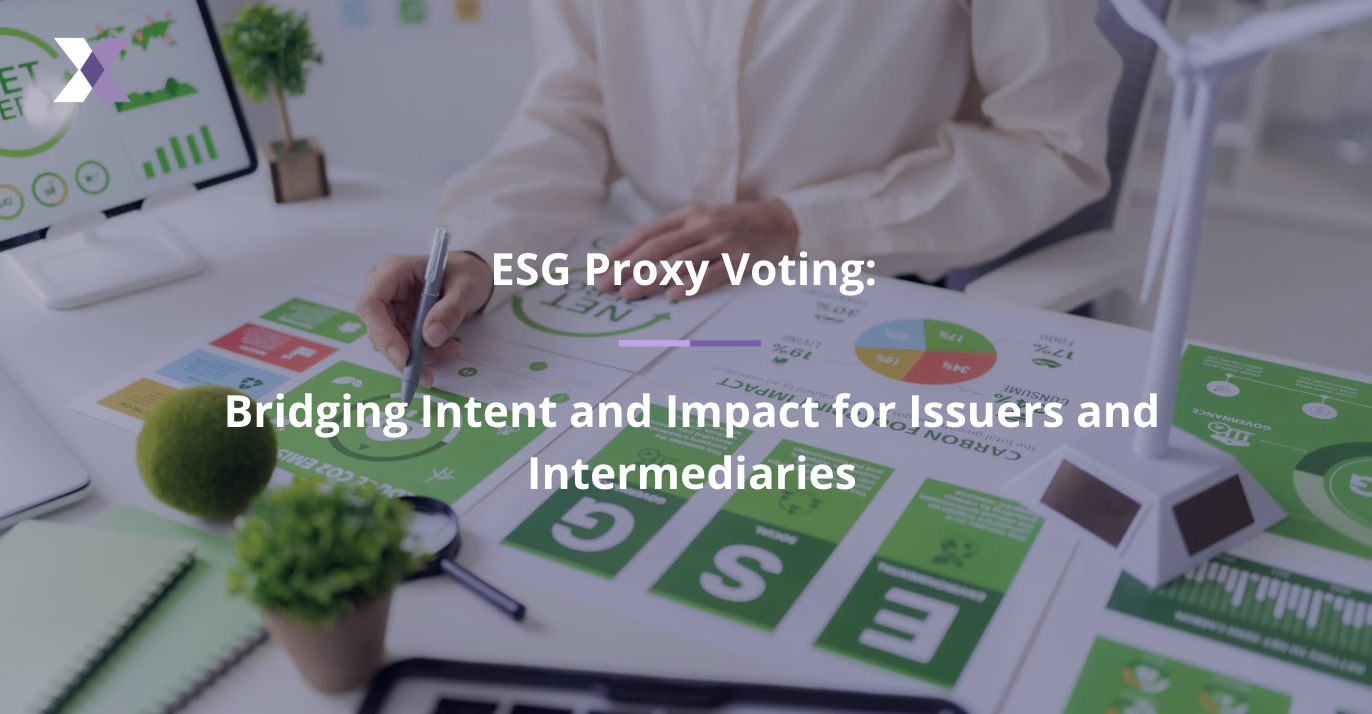Views
ESG Proxy Voting: Bridging Intent and Impact for Issuers and Intermediaries

As ESG issues climb higher on the agenda for investor relations teams, corporate secretaries and intermediaries, particularly across Europe and Asia, the way shareholders engage has never mattered more, both in and out of proxy season.
According to EY’s Global Institutional Investor Survey, 73% of investors say they evaluate non-financial disclosures in a “structured and methodical” way, which evidences the growing interest in aspects like ESG among shareholders.
Yet, as Harvard Business Review notes, while ESG-related proposals are increasing, meaningful influence often lags. (To dive deeper into the ESG vs anti-ESG divide, explore our piece on “Anti‑ESG Shareholder Proposals: What Does It Mean for Issuers?”)
Despite this momentum, many issuers and intermediaries still depend on slow, manual, and opaque proxy voting systems, leaving investor intent unclear and opportunities for real engagement lost.
Modern digital infrastructure is the key to bridging this gap and enabling transparent, impactful ESG proxy voting.
What are some common proxy voting gaps in ESG?
Despite its importance, the current proxy voting infrastructure presents significant obstacles:
Transparency and operational issues
Delays and errors are often caused by decades-old processes involving manual communications, multiple intermediaries and fragmented data. Audit trails are weak. Investors can’t confirm their votes were received or counted properly.
While legacy proxy voting providers in the market have established services, many fall short on real-time feedback loops, auditability and true transparency for ESG-centric workflows.
Regulatory and political headwinds

Regulators have placed growing scrutiny on proxy advisors like ISS and Glass Lewis and ESG-related governance, creating uncertainty for all parties. Policies and frameworks evolve rapidly, complicating governance teams’ planning.
Proxy advisor influence and voting structure issues
Compensation models of proxy advisors and mechanisms like dual-class shares can skew voting outcomes, reducing minority shareholder influence and undermining ESG-related votes.
Data and resource constraints
Many firms still lack integrated systems that connect ESG data with proxy voting, making it difficult for investors to align stewardship goals with actual execution.
This gap often forces investors to rely on proxy advisors like ISS and Glass Lewis, or major asset managers like BlackRock, simply due to limited time and resources. The UK’s FRC found that investors frequently depend on these recommendations instead of conducting their own analysis.
Timing poses another challenge; as noted in Proxy and Class Actions: Today’s ESG Challenge, it can take up to 16 days for notifications to reach investors.
As Proxymity COO Jonathan Smalley explained in Building Investor Relationships by Leveraging Voting Insights, ‘This delay, in turn, diminishes the time available for shareholders to thoroughly evaluate their voting options and, at times, even casts doubt on the accurate recording of votes.’
Enabling accurate and verifiable ESG voting
To unlock meaningful ESG outcomes, organisations must move from intention to action, and that requires infrastructure fit for purpose.
According to our research, over 60% of investors said they would target investments based on an issuer’s shareholder engagement score if available, underscoring the demand for verified and auditable participation.
In practical terms, this means issuers and intermediaries must ensure:
• Votes are transmitted and confirmed in real-time, reducing the risk of under- or over-voting and enabling audit trails.
• Voting processes align with ESG policies and remain transparent to all parties—from asset manager to issuer.
• Engagement programmes connect seamlessly with proxy workflows ensuring that investor intent is reflected in vote execution.
In other words, intent (investor-driven ESG priorities) and impact (verifiable votes on ESG resolutions) must be linked through the custody and voting chain.
Modern proxy voting solutions bridge this gap by providing accurate vote tracking, comprehensive audit capabilities and clearer visibility into investor behaviour tied to ESG themes.
How digital platforms transform ESG proxy voting

This is where centralised digital platforms like Proxymity come in. With our Vote Connect solution, the entire custody chain becomes unified, enabling real-time, accurate, transparent vote transmissions. Investors send voting instructions. Issuers receive confirmed outcomes. Manual interventions become a thing of the past.
The Shareholder Insights Suite offers a layer of analysis for issuers to understand investor intent, voting behaviour and ESG-driven patterns.
Consider an issuer preparing for an AGM with multiple ESG resolutions. Through Proxymity’s digital proxy voting platform, intermediaries enabled real-time vote connectivity between the issuer and its investors. This early visibility into shareholder intentions allowed the company to address ESG engagement gaps before the meeting, while investors benefited from transparent, confirmed vote transmission.
The result? Smoother execution, higher vote confirmation rates, and stronger stewardship credibility across the custody chain. Verified participation is fast becoming a competitive edge in governance – a trend already visible in markets through adoption by leading intermediaries such as State Street and BNP Paribas Securities Services.
ESG proxy voting driven by actual shareholder intent
For genuine ESG stewardship powered by proxy voting, verified participation is foundational. Issuers, intermediaries and institutional investors must rethink proxy voting processes in light of digital transformation and sustainability mandates.
Explore how our solutions can elevate your ESG engagement, restore trust in voting outcomes and turn shareholder intent into measurable impact.
Need to learn more? Head to our governance resources, book a demo or contact us today.
Frequently Asked Questions (FAQs) regarding ESG proxy voting
What is proxy voting ESG?
It is the use of proxy voting rights to influence ESG-related resolutions and steer governance outcomes aligned with sustainability objectives.
What kinds of ESG proposals are voted on?
These range from climate risk disclosures, board diversity targets, executive pay aligned with sustainability, to social-impact and governance reforms. Have a read of our piece on corporate governance issues to discover more such proposals.
What is the role of proxy voting in ESG engagement?

Proxy voting plays a key role in ESG by amplifying shareholder voices, aligning investor intent with corporate decisions, and driving accountability for sustainability commitments. It helps protect long-term value by addressing ESG risks and provides a formal channel to turn investor dialogue into action.
With rising growth in retail ESG participation as well, proxy voting, combined with disclosure reporting, can be a key engagement enabler.
How are votes processed?
Institutional investors, intermediaries and retail shareholders cast votes via custodians/registrars following agenda release; votes are aggregated and sent to issuers for tabulation.
How to approach ESG-related proxy voting?
Begin by ensuring your infrastructure is capable of accurate vote transmission, real-time confirmation, and robust data insights; then link your engagement programmes to proactive voting strategies.
How do financial institutions such as banks and investment funds contribute to sustainable finance through ESG?
Banks and investment funds advance sustainable finance by directing capital toward companies with strong ESG performance and using proxy voting to hold them accountable. Through informed voting and engagement, they influence corporate behaviour, promote transparency, and ensure that sustainability goals translate into measurable outcomes for investors and society.
